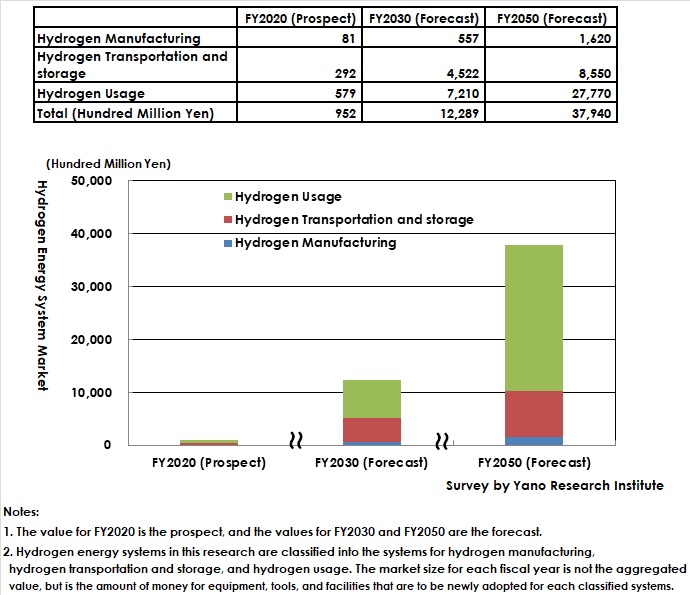No.2523
Hydrogen Energy Systems Market in Japan: Key Research Findings 2020
Market Driven by FCVs and Hydrogen Stations, Overseas Large-Scale Projects Expected to Build Inexpensive Hydrogen Supply Chains
Yano Research Institute (the President, Takashi Mizukoshi) carried out a survey on the current status and future direction of domestic hydrogen energy systems market, and forecasted the market size in FY2030 and FY2050.

Market Overview
The Basic Hydrogen Strategy was formulated by METI in December 2017 to outline Japan’s future visions for achieving a world-leading hydrogen-based society with an eye on 2050, and to serve as an action plan to accomplish these visions by 2030. The final goal for introducing hydrogen energy systems is to prevent further global warming by adopting CO2-free hydrogen and by expanding the use of renewable-energy derived electricity as regulated power supply.
Noteworthy Topics
Ene-Farm (Residential Fuel Cell)
An Ene-Farm (residential fuel cell) is a system that generates power through a chemical reaction combining hydrogen extracted from LP gas or city gas with oxygen in the air, and utilizes the generated heat to supply hot water and heating. There are two types of Ene-Farm systems, i.e. PEFC (polymer electrolyte fuel cell) and SOFC (solid-oxide fuel cell), differ by the operational temperature of fuel cells: While PEFC can operate at low temperatures from 70 to 90°C, COFC needs to be operated at 700 to 1,000°C due to utilization of ceramics for an electrolyte material.
PEFC Ene-farm systems (700W models) are mainly sold for newly built houses. Many house manufacturers have started adopting the models into their residences. Recently, PEFCs are increasingly introduced as a part of ZEH (net zero energy house) schemes. Almost half of all PEFC sales are within a part of the newly built ZEH projects.
SOFC Ene-farm systems have “type S (700W model)” and “mini (400W model).” While the former models appeal to small-size and high-efficiency, useful for apartment rooms with only limited spaces, the latter models have become available for existing apartments and detached houses where no such systems were able to be installed before.
The hydrogen-based society for future should not only need Ene-Farm systems that use city gas to extract hydrogen but should also need pure hydrogen to be popularized. Pure-hydrogen fuel cells use CO2-free hydrogen. Conventionally, ene-farm systems were promoted chiefly by city gas enterprises. The future challenge is to decide who are to promote hydrogen hereafter.
Future Outlook
Based on the forecasted size of hydrogen energy systems market in Japan in FY2020, which are total 95.2 billion yen (of which hydrogen manufacturing systems generate 8.1 billion yen, hydrogen transportation and storage systems 29.2 billion yen, and hydrogen usage systems 57.9 billion yen), the market size for FY2030 is expected to expand to total 1,228.9 billion yen (of which hydrogen manufacturing systems are to generate 55.7 billion yen, hydrogen transportation and storage systems 452.2 billion yen, and hydrogen usage systems 721.0 billion yen) and that for FY2050 total 3,794.0 billion yen (of which hydrogen manufacturing systems are to generate 162.0billion yen, hydrogen transportation and storage systems 855.0 billion yen, and hydrogen usage systems 2,777.0 billion yen.)
Research Outline
2.Research Object: Energy suppliers, facility manufacturers, automakers, engineering companies
3.Research Methogology: Face-to-face interviews by the expert researchers, surveys via telephone and email, and literature research
The Hydrogen Energy System Market
A hydrogen energy system enables to procure hydrogen by manufacturing hydrogen via renewable power and by introducing large volume of CO2-free hydrogen at overseas projects and to transport it to energy consuming locations in the forms of liquefied hydrogen, organic hydride, ammonia, etc. to be utilized for hydrogen power generations, for fuel cells, and for FCV fuels. Also by managing supply and demand of electricity, excess electricity such as from renewable energy can be used for manufacturing, transportation, and storage of hydrogen for use when necessary. By converting electricity to hydrogen (Power to Gas: P2G), large volume of energy can be stored for a long period of time and can be transported to long-distant locations.
The hydrogen energy systems are defined in this research as those systems that involve in the following three types: manufacturing of hydrogen, transportation and storage of hydrogen, and usage of hydrogen.
The hydrogen energy systems market size for FY2020 was calculated as the prospect, and that for FY2030 and FY2050 was calculated as the forecasts. The market size for each fiscal year is not the aggregated value, but the amount of money for equipment, tools, and facilities that are to be newly adopted for each classified systems.
Published Report
Contact Us
The copyright and all other rights pertaining to this report belong to Yano Research Institute.
Please contact our PR team when quoting the report contents for the purpose other than media coverage.
Depending on the purpose of using our report, we may ask you to present your sentences for confirmation beforehand.